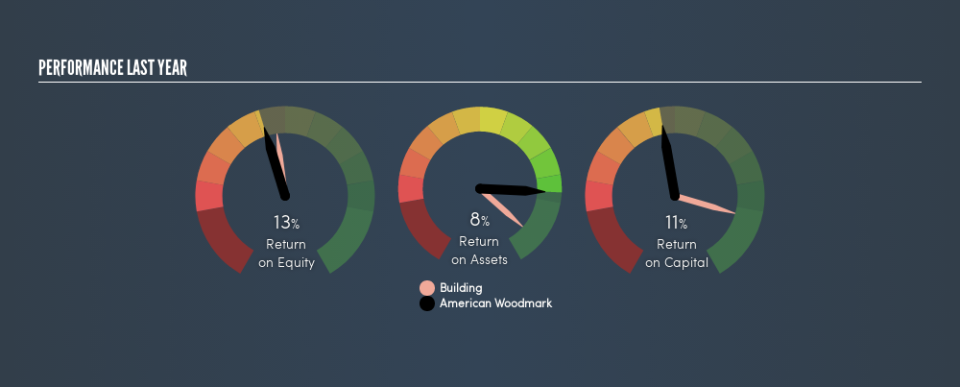Should You Worry About American Woodmark Corporation’s (NASDAQ:AMWD) ROCE?

Want to participate in a research study? Help shape the future of investing tools and earn a $60 gift card!
Today we’ll look at American Woodmark Corporation (NASDAQ:AMWD) and reflect on its potential as an investment. Specifically, we’ll consider its Return On Capital Employed (ROCE), since that will give us an insight into how efficiently the business can generate profits from the capital it requires.
First, we’ll go over how we calculate ROCE. Next, we’ll compare it to others in its industry. Finally, we’ll look at how its current liabilities affect its ROCE.
What is Return On Capital Employed (ROCE)?
ROCE is a measure of a company’s yearly pre-tax profit (its return), relative to the capital employed in the business. In general, businesses with a higher ROCE are usually better quality. Ultimately, it is a useful but imperfect metric. Author Edwin Whiting says to be careful when comparing the ROCE of different businesses, since ‘No two businesses are exactly alike.’
How Do You Calculate Return On Capital Employed?
Analysts use this formula to calculate return on capital employed:
Return on Capital Employed = Earnings Before Interest and Tax (EBIT) ÷ (Total Assets – Current Liabilities)
Or for American Woodmark:
0.11 = US$150m ÷ (US$1.5b – US$143m) (Based on the trailing twelve months to January 2019.)
Therefore, American Woodmark has an ROCE of 11%.
See our latest analysis for American Woodmark
Is American Woodmark’s ROCE Good?
When making comparisons between similar businesses, investors may find ROCE useful. In this analysis, American Woodmark’s ROCE appears meaningfully below the 15% average reported by the Building industry. This performance could be negative if sustained, as it suggests the business may underperform its industry. Separate from American Woodmark’s performance relative to its industry, its ROCE in absolute terms looks satisfactory, and it may be worth researching in more depth.
As we can see, American Woodmark currently has an ROCE of 11%, less than the 25% it reported 3 years ago. This makes us wonder if the business is facing new challenges.
It is important to remember that ROCE shows past performance, and is not necessarily predictive. Companies in cyclical industries can be difficult to understand using ROCE, as returns typically look high during boom times, and low during busts. This is because ROCE only looks at one year, instead of considering returns across a whole cycle. What happens in the future is pretty important for investors, so we have prepared a free report on analyst forecasts for American Woodmark.
How American Woodmark’s Current Liabilities Impact Its ROCE
Current liabilities are short term bills and invoices that need to be paid in 12 months or less. Due to the way the ROCE equation works, having large bills due in the near term can make it look as though a company has less capital employed, and thus a higher ROCE than usual. To check the impact of this, we calculate if a company has high current liabilities relative to its total assets.
American Woodmark has total assets of US$1.5b and current liabilities of US$143m. As a result, its current liabilities are equal to approximately 9.3% of its total assets. In addition to low current liabilities (making a negligible impact on ROCE), American Woodmark earns a sound return on capital employed.
Our Take On American Woodmark’s ROCE
This is good to see, and while better prospects may exist, American Woodmark seems worth researching further. Of course you might be able to find a better stock than American Woodmark. So you may wish to see this free collection of other companies that have grown earnings strongly.
For those who like to find winning investments this free list of growing companies with recent insider purchasing, could be just the ticket.
We aim to bring you long-term focused research analysis driven by fundamental data. Note that our analysis may not factor in the latest price-sensitive company announcements or qualitative material.
If you spot an error that warrants correction, please contact the editor at editorial-team@simplywallst.com. This article by Simply Wall St is general in nature. It does not constitute a recommendation to buy or sell any stock, and does not take account of your objectives, or your financial situation. Simply Wall St has no position in the stocks mentioned. Thank you for reading.

